Date: 13th May 1940 (Monday)
Unit: No. 264 Squadron
Type: Defiant I
Serial: L6977
Base: Duxford (via Martlesham)
Location: Rijsdijk dyke, Willemspolder
Pilot: P/O. Patrick Greenhous R.A.F. P.O.W.
Air/Gnr: Sgt. Frederick Greenhalgh R.A.F. P.O.W.
REASON FOR LOSS:
Took off at 04.15 hrs from Martlesham along with 5 other Boulton Paul Defiant's together with 6 Spitfires from 66 Squadron. The object being to patrol the Dutch coast between Ijmuiden and the Hague to attack German troop transport.
They flew across the North Sea, making landfall about ten miles north of The Hague at 0515, after which all aircraft turned north.
Over IJmuiden they were fired on by Dutch anti-aircraft guns located on the south side of the harbour. The guns were firing accurately but they ceased fire immediately the British signalled the Dutch letter of the day. All aircraft turned about and flew south along the coast. More fire, this time German, was met over Maassluis which caused sections to take evasive action.
Shortly after, the No. 66 Squadron Spitfires turned east towards Rotterdam where there were fires raging in various places while the Defiant's followed a more southerly route. Approaching Rotterdam, the crews of both flights saw about seven German Ju 87 Stukas (belonging to 12. Staffel of Lehrgeschwader 1) dive-bombing a target to the south-east.
The Defiant's went in to the attack and a ferocious air battle developed. Shortly after, Bf 109s from 5. Staffel of Jagdgeschwader 26 joined the battle, which then developed into a series of individual dogfights.

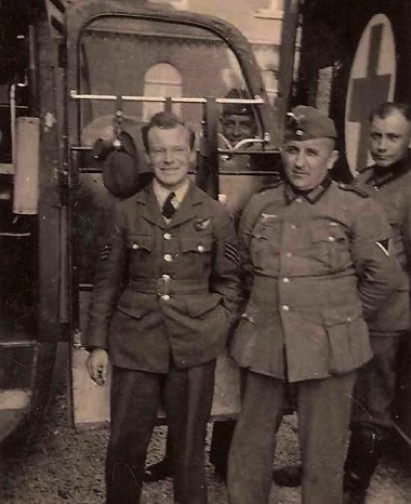
Above left: P/O. Patrick Greenhous. Right: Sgt. Frederick Greenhalgh (Source Jan Jolie)
During the air battle over the Biesbosch, the gunner of L6977, Sergeant Fred Greenhalgh, claimed two Bf 109s before their own plane was hit and he bailed out from the damaged and rapidly descending aircraft.
Pilot Officer Patrick Greenhous, however, was under the impression that Greenhalgh was still aboard and tried to make an emergency landing putting the Defiant down in a meadow adjoining the Rijsdijk dyke in the Willemspolder at Oosteind, part of Oosterhout municipality. Greenhous landed safely, as did Greenhalgh by parachute, but both men were captured by German soldiers and transported to POW camps.
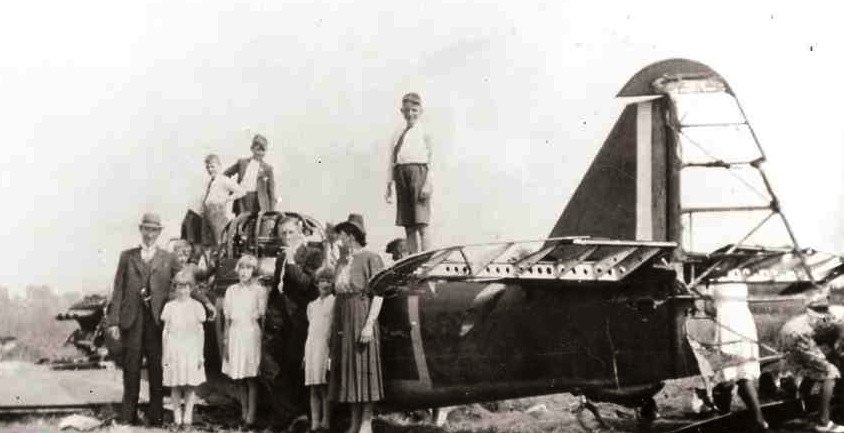
Greenhous went to Stalag Luft 3 at Sagan in Poland while Greenhalgh was taken to Camp No. 344 at Lambsdorf in Germany. In May 1945, after Greenhous had been freed from captivity and was on his way back to England, he happened to meet up with his old No. 264 Squadron, then based at airfield B-108 near the German town of Rheine. It was only when he filed his report with the unit’s Intelligence Officer that it became clear what happened to him and his aircraft five years earlier:
‘We were flying in a formation of six Defiants accompanied by six Spitfires from No. 66 Squadron. After flying along the Dutch coast we saw heavy flak just south of the Hook so we turned about and flew down the coast again and, when approaching Rotterdam, sighted a formation of Me 110s which we engaged at a height of 15,000 feet.
The Me 110s broke off engagement but we were then attacked by 12 Me 109s flying in line astern. My gunner gave the leading enemy aircraft a short burst and it caught fire and went down in flames. He immediately turned his attention to the second enemy aircraft and scored a number of hits, following which it went down out of control, and was seen to hit the ground.
Both the enemy aircraft fell in the Breda area. Shortly afterwards however we ourselves were hit, our guns were put out of action, and our starboard petrol tank caught fire. A cannon shell landed in the cockpit and injured me in the head. I then found that the intercom was unserviceable so, as pre-arranged, I rocked the aircraft as a signal for my gunner to bail out. As this produced no response, I thought he must have been wounded so decided to make a crash-landing, which I managed to do.
Unfortunately we landed in the middle of a mobile German infantry unit but, even so, they had to chase us on before we were captured by a German officer on a motor bike. As a result I have spent the last five years in a number of German prison camps. I claim two Me 109s destroyed.’
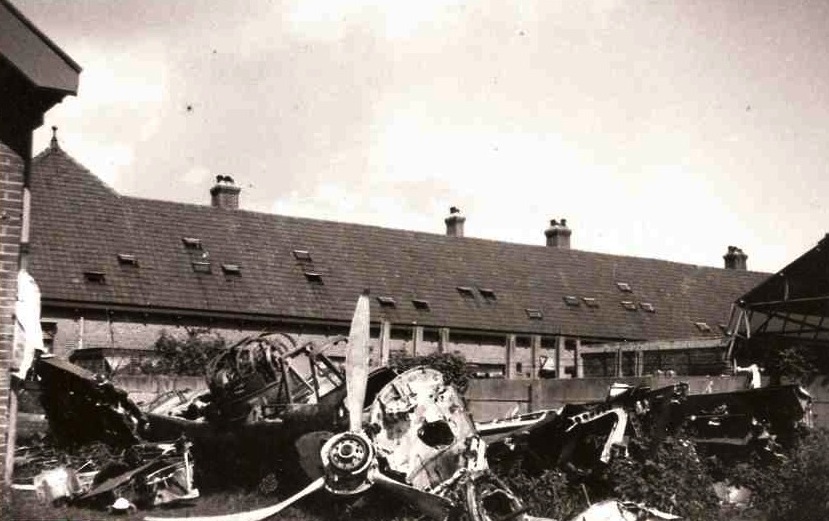
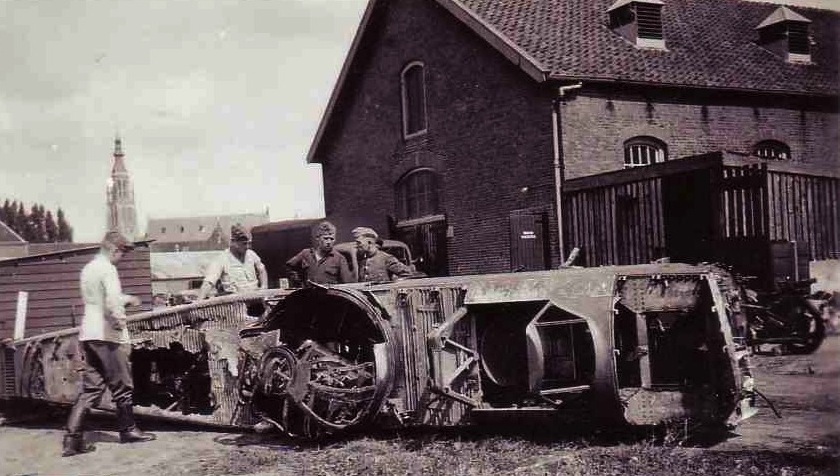
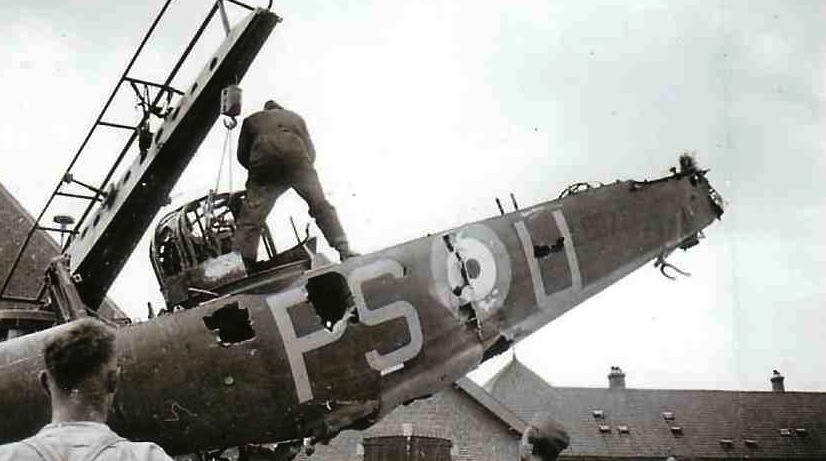
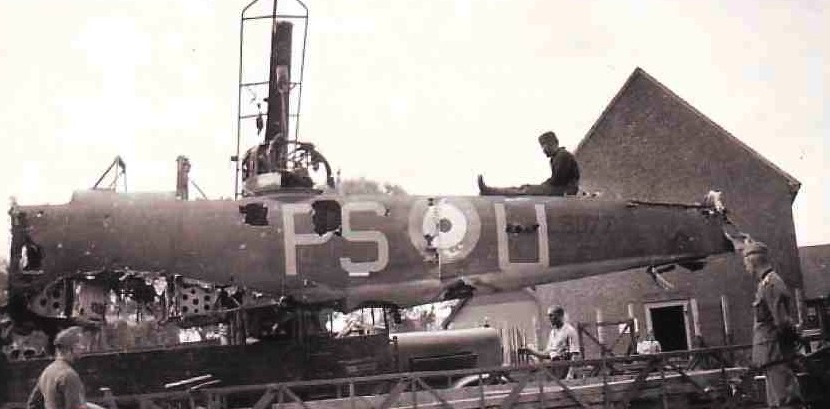

Taking away L6977 (Source Jan Jolie)
Two Dutchmen, brothers Kees and Jan Jespers, who were working in the fields behind their family farm, saw the crash of L6977. Although they went to the scene immediately, they were not really able to help Greenhous because they spoke hardly any English. He gave them his flying suit and a name card. They later saw the Germans take him prisoner. After the war, in a letter to Dutch researchers, Greenhous related more details of the crash and his subsequent experiences:
‘After we had been hit the starboard fuel tank caught fire. I succeeded in extinguishing the fire by carrying out a sideways dive.
However, the engine had also been hit and as a result it ceased to rotate. At that point I was flying at an attitude of less than 1,000 feet. I therefore headed for the first field I could see.
I struggled from the plane, walked around towards the turret and discovered very quickly that Sergeant Greenhalgh had heeded the signal to bail out of the plane.
Afterwards I heard that he had not been wounded and had been captured by the Germans. A few years later I saw him again in one of the POW camps. In 1949 he came to see me in Shrewsbury in Shropshire where I was living at the time. He stayed in the RAF as a weapons instructor but that is the only information I have about him. I have never seen him since.

Stalag Luft 1 Left to right: Jackson (City of London Squadron), Milner, Patrick Greenhous, Nat Fowler (escaped - later killed in an air accident over England) Denholm, Ian Potts (R.N.Z.A.F.) Tigger the cat. (Source Jan Jolie)
‘After the emergency landing I was picked up by some Germans who were riding on a motorcycle and sidecar. They applied an emergency bandage to my head wound and took me to a school at St Oedenrode. This school was being used as a temporary POW camp for Dutch and French soldiers. The Germans did not believe that I was an officer and made me clean blocked toilets with my bare hands. The Dutch soldiers were very friendly as were the adults and children in the town who came every day to bring me food which they passed through the fence.
After about a week I was transferred to concentration camp F6 in Bocholt, Germany, and was held in solitary confinement. During my stay there an American journalist visited the camp and interviewed me for a New York newspaper. In the meantime my parents had received a telegram stating that I was missing in action. Thanks to the American newspaper article they discovered that I was still alive and being held as a prisoner of war.
From Bocholt I was transferred to camp Dulag Luft near Frankfurt.
After a few weeks I was transferred with part of my group to Stalag Luft 1 at Barth Vogelsang near the coast at Stettin. During my stay there I participated in the digging of at least 40 escape tunnels. All these attempts were discovered fairly soon by the Germans because we had problems with ground water at a depth of about 4 feet due to the vicinity of the coast. Subsequently I was moved to Stalag Luft 3 at Sagan in Poland. From this camp the great escape of 52 officers took place but they were all captured and shot by the Gestapo. Fortunately I was not among them.
‘In January 1945 it was bitterly cold and we were told to prepare for departure. We were only allowed whatever we could carry ourselves. From an easterly direction we heard the sound of gun-fire. The Russians were approaching the River Oder. We walked for three or four days and slept in the open or in barns. Those who could not keep up were left behind to die.
We arrived at a station where we were loaded into cattle trucks and after a long journey we arrived at the Marlag naval camp between Bremen and Hamburg. There we were liberated by the King's Shropshire Light Infantry and sent in empty munitions wagons to Brussels. As we were passing through Rheine we saw Wing Commander Eric Barwell (a friend of mine from No. 264 Squadron)( Wing Commander Eric Barwell, DFC and Bar, was born on August 6, 1913,. He died on December 12, 2007, aged 94) in a Jeep. I shouted to him and he recognised me immediately. He asked me and two of my friends to join him and he took us to the airfield.
As it happened No. 264 Squadron were stationed there with their Mosquitoes from May 6 to May 14. You can understand that the reunion turned into a terrific party.
‘The next day we were flown back to England in the squadron Oxford. Upon our arrival home we received a tremendous welcome and after being demoted were given travel warrants. I was met at the station by my mother and sister, who were both very excited because of all the boys in our family I was the only survivor. My eldest brother had been buried under the sand during the evacuation from Dunkirk and died later in a military hospital. My younger brother was killed during the battles in Burma in 1944.’
The local history society of Oosterhout decided to erect a memorial on Rijsdijk to commemorate Greenhous's emergency landing and to unveil the memorial on October 30, 1998, exactly 44 years after the liberation of Oosterhout by the British 7th Armoured Division.
Unfortunately, due to an eye operation, Patrick Greenhous was unable to attend but the committee decided to go ahead with the unveiling which attracted a lot of public attention.
The present author together with the Burgomaster W. R. Ligtvoet of Oosterhout unveiled the memorial, the work of local artist Ad van Beekhoven, and Kapitein H. A. Spierings of the Dutch Air Force Recovery Service laid a wreath. The British Military & Air Attaché, Lieutenant-Colonel C. A. Le Hardy, was also present.
The ceremony concluded with a fly-past by a Harvard – a moving moment for eyewitnesses to the crash so many years before. Afterwards a number of people were invited to the local community hall, where the history society had set up a small exhibition on the crashes of the Defiants of No. 264 Squadron in the area, one very special item being the remains of Defiant L6958 that had been made available by the Dutch Air Force Recovery Service from Woensdrecht.
The Balance Sheet May 13th 1940 (Here)
Researched by Jan Jolie (Dutch researcher)
